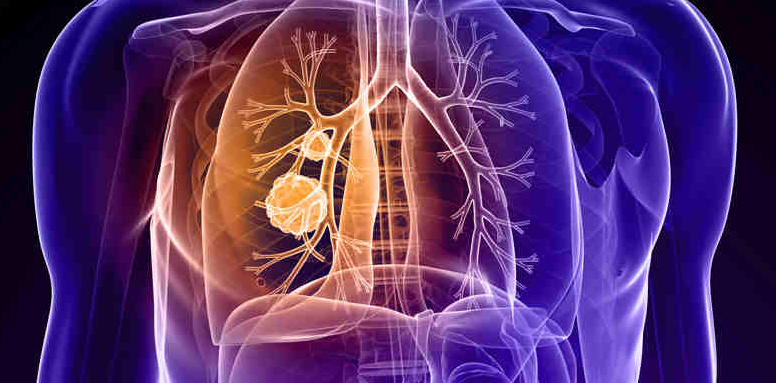From the journals: JBC
An antibody that treats lung cancer. A new method to tackle toxic tau. A link between carbs and liver fat. Read about papers on these and other topics in the Journal of Biological Chemistry.
A dual-acting antibody to treat lung cancer
Lung cancer remains the leading cause of cancer deaths worldwide, and non–small cell lung cancer, or NSCLC, is the most common type, accounting for 84% of all lung cancer diagnoses according to the American Cancer Society.
In 2004, researchers found that activating mutations of the epidermal growth factor receptor, or EGFR, and mesenchymal–epithelial transition factor, or MET, cell signaling pathways drive tumor proliferation and growth in NSCLC patients. This discovery led to the development of tyrosine kinase inhibitors, or TKIs, targeting the EGFR, which are now the standard of care for NSCLC patients with EGFR mutations; however, many patients go on to develop resistance to TKIs, making future treatments ineffective. A similar resistance is developed against MET pathways, and strategies combining TKIs that target MET and EGFR cannot overcome the wide range of mechanisms responsible for the development of resistance. For these reasons, researchers now seek new treatment strategies that can circumvent resistance and achieve therapeutic benefit.
Enter bispecific antibodies, or bsAbs — a family of molecules that can recognize two different epitopes or antigens. This makes them attractive candidates for targeting and acting on two separate biological targets. In a recent study published in the Journal of Biological Chemistry, Joost Neijssen of Genmab and an international team of collaborators including researchers at Janssen Pharmaceuticals developed a bsAb that can target EGFR and MET.
Using sequential screening methods, the team sorted through a panel of bsAbs derived from EGFR and MET antibodies. The researchers used tumor cell lines to assess the ability of the bsAbs to bind EGFR and MET as well as alter signaling pathways. After a lead bsAb candidate emerged, the researchers used antibody engineering to boost therapeutic potency and named the resulting product amivantamab. Using X-ray crystallography, the researchers revealed the atomic details of amivantamab when bound to its target molecules, and they showed that the bsAb effectively halts tumor-promoting cell signaling both in cultured cells and in a cancer animal model.
Based on its unique mode of action, amivantamab could be a powerful treatment for NSCLC, particularly in patients whose disease has developed resistance. Since the publication of this paper, Janssen has sought Food and Drug Administration approval of amivantamab for treating patients with NSCLCs that contain mutations in the EGFR gene.

What triggers toxic tau?
Alzheimer’s disease, which affects more than 6 million Americans age 65 or older, is typified by the presence of abnormal proteins in brain cells, called amyloid plaques and tau tangles. Treatment for the disease — which remains incurable, with only symptomatic relief available — has focused on the elimination of amyloid plaques and has failed largely in clinical trials. Recently, researchers are looking at tau, a protein that interacts with cellular support elements called microtubules, as a therapeutic target.
In a paper published in the Journal of Biological Chemistry, Alberto Carpentino Soares and colleagues at Janssen Pharmaceuticals studied how endosomal pathways, pathways that sort and deliver cargoes within cells, may take in misfolded tau proteins from the extracellular environment and spread them in a cell, where these proteopathic tau proteins can seed new misfolded tau aggregates. Using drug studies, microscopy and biochemical techniques, the researchers identified the proteins dynamic-1, actin and Rac1 as key players in the spread of toxic tau seeds in cultured cells. The authors also discovered that disruption of the activity of PIKfyve, a protein downstream of Rac1, reduced both the trafficking of toxic tau seeds and the buildup of misfolded tau.
This work shows that tau aggregates can be internalized by a process involving endosomes and that the consequences of their internalization can be altered using pharmacological compounds, which may represent a promising therapy for the treatment of Alzheimer’s disease and other tauopathies.
Archaic enzyme creates new phospholipids
Cardiolipins, or CLs, are a class of lipids that assist with the organization of membranes, enzyme functioning and regulation of water in cells. Researchers have studied the biosynthesis of CLs extensively in eukaryotes and bacteria but not in archaea, which have membranes made up of phospholipids that differ structurally from eukaryotes. As a result, cardiolipin biosynthesis processes may differ in archaea.
In recent work published in the Journal of Biological Chemistry, Marten Exterkate of the University of Groningen and colleagues identified the cardiolipin synthase from the archaea Methanospirillum hungatei. Using liquid chromatography–mass spectrometry, the authors characterized this enzyme’s activity and discovered that it uses the substrates archaetidylglycerol and phosphatidylglycerol indiscriminately to generate its products: glycerol-di-archaetidyl-cardiolipin, or Gro-DACL, and glycerol-di-phosphatidyl-cardiolipin, or Gro-DPCL, respectively. This promiscuity enables the enzyme to process both substrates when they’re presented simultaneously, resulting in an archaeal–bacterial hybrid cardiolipin that is not found in nature. The ability of this enzyme to create unnatural phospholipid species may be of interest for biocatalytic purposes.
Linking carbs and liver fat
An increasing number of people around the world are developing disorders characterized by metabolic dysfunction. Among these is nonalcoholic fatty liver disease, or NAFLD, which is characterized by excessive liver fat accumulation in individuals without a history of alcohol abuse. The overconsumption of dietary sugars is associated with the disease; however, researchers do not yet understand the processes responsible for the generation of fat, or lipogenesis, in liver cells.
Using recombinant adenovirus experiments, immunoprecipitation, nuclear localization studies and gene expression analysis, P. Vineeth Daniel and colleagues at the Indian Institute of Technology Mandi established a link between increased lipogenesis and nuclear factor kappa-light-chain-enhancer of activated B cells, or NF-κB. The authors showed that a high-carbohydrate diet caused the shuttling of liver NF-κB p65, a component of NF-κB, and repressed transcript levels of sorcin, a cytosolic interacting partner of the lipogenic transcription factor carbohydrate response element-binding protein, or ChREBP. The researchers went on to show that the resulting reduced sorcin levels prompted ChREBP nuclear translocation, leading to enhanced new lipogenesis and fat accumulation in the cultured liver cells and in the livers of mice fed a high-carb diet.
These findings, published in the Journal of Biological Chemistry, describe a previously unknown role of NF-κB in regulating the biological response to high-carb diet and may be useful in developing treatments for NAFLD.
Enjoy reading ASBMB Today?
Become a member to receive the print edition four times a year and the digital edition monthly.
Learn moreGet the latest from ASBMB Today
Enter your email address, and we’ll send you a weekly email with recent articles, interviews and more.
Latest in Science
Science highlights or most popular articles

Mining microbes for rare earth solutions
Joseph Cotruvo, Jr., will receive the ASBMB Mildred Cohn Young Investigator Award at the ASBMB Annual Meeting, March 7–10, just outside of Washington, D.C.

Fueling healthier aging, connecting metabolism stress and time
Biochemist Melanie McReynolds investigates how metabolism and stress shape the aging process. Her research on NAD+, a molecule central to cellular energy, reveals how maintaining its balance could promote healthier, longer lives.

Mapping proteins, one side chain at a time
Roland Dunbrack Jr. will receive the ASBMB DeLano Award for Computational Biosciences at the ASBMB Annual Meeting, March 7–10, just outside of Washington, D.C.

Exploring the link between lipids and longevity
Meng Wang will present her work on metabolism and aging at the ASBMB Annual Meeting, March 7-10, just outside of Washington, D.C.

Defining a ‘crucial gatekeeper’ of lipid metabolism
George Carman receives the Herbert Tabor Research Award at the ASBMB Annual Meeting, March 7–10, just outside of Washington, D.C.

The science of staying strong
Muscles power every movement, but they also tell the story of aging itself. Scientists are uncovering how strength fades, why some species resist it and what lifestyle and molecular clues could help preserve muscle health for life.

